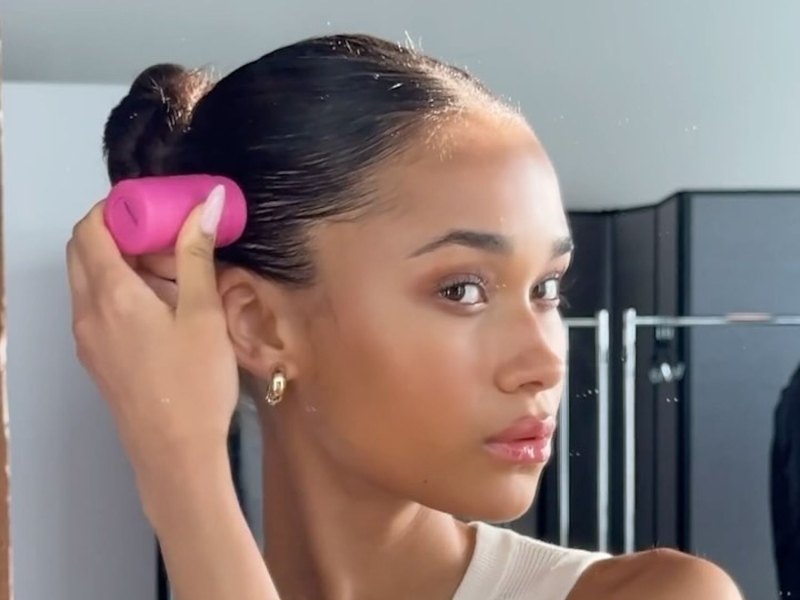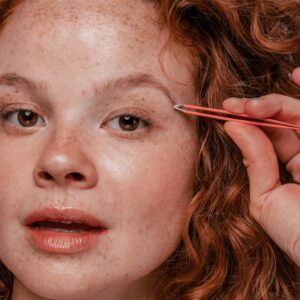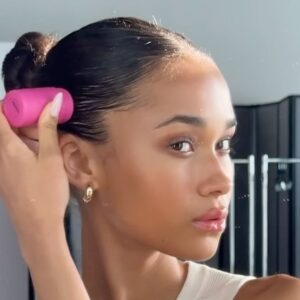
Dealing with breakouts can be a frustrating experience, especially when you’re not sure why a given flare-up is happening or how to resolve it. Environmental factors, diet, hormones, and skincare products are among the leading causes, and often the solution lies within trial and error and elimination methods. But did you know that your hair products can sometimes be the root of your breakouts? Luckily, there are several ways to improve your situation once you’ve determined this is a possible cause. Ahead, we asked two dermatologists about why hair products can cause breakouts, as well as their top tips on how to prevent and minimize them.
Can Hair Products Really Cause Breakouts?
Breakouts can happen due to a variety of environmental factors, and much like skincare that doesn’t agree with your skin type and sensitivities, hair products can lead to breakouts. “Hair products can cause a type of acne known as ‘pomade acne’ or ‘acne cosmetica’ that usually manifests with whiteheads and tiny flesh-colored bumps on the forehead, hairline, and/or back,” explains board-certified dermatologist Lauren Penzi, MD. “This is usually due to ingredients in the hair products that are comedogenic, a.k.a. [have the ability to] clog pores, like oils, silicones, and waxes.”
Studies support this notion, finding that often, hair care products can leave a residue on the skin, even after washing the products off with a face wash or shampoo. This residue can lead to acne, and the eight-week study further supports that a non-comedogenic hair routine generally led to improvement in mild to moderate truncal and facial acne.
How to Prevent Breakouts from Hair Products
Avoid Pore-Clogging Ingredients
If you begin to notice unwanted acne, take a closer look at your skincare and haircare ingredients across the board. You’ll want to do your best to avoid anything that can knowingly cause breakouts.
“Switch to products with non-pore-clogging ingredients,” Penzi emphasizes. “It should say ‘Won’t clog pores, oil free, non-comedogenic, or non-acnegenic.'” This is a helpful elimination technique, as it will help determine the root of your acne, whether it’s product-related or caused by something else.
Wash Your Bedding
Keeping your bedding clean might not be the first thing you think of when it comes to promoting clear skin, but it can have a major impact. It’s generally best to wash your sheets and pillowcases once a week, and while this sounds like an obvious task, plenty of people forget to stay on top of this amidst a busy schedule (so we totally understand if this has been you). That being said, it’s important in the journey to help eliminate or minimize breakouts.
"Make sure to change or wash your pillowcases and sheets, caps, hats, headbands, and visors," Penzi shares. "This is because residue from the hair care products can remain on these items."
Avoid Product to Skin Contact
Often, our favorite products (like heat protectant) come in a spray bottle, which may be helpful for even distribution but can make it difficult to target your hair while avoiding your skin. On that same note, it’s easy to accidentally end up with non-spray products (like leave-in conditioners) on your skin, especially if you apply them with abandon and/or touch your forehead or cheeks while gliding your hands through your hair. Our experts say that this is worth being conscious of so you can avoid it when possible.
So how do you go through your hair routine more carefully to save your skin while still getting the maximum benefits for your strands? "Avoid applying hair products directly to the skin, and always wash your hands after applying hair products," Penzi says.
Wash Your Hair Before Your Body
Sometimes it’s the little things that make a big difference, and in this case, the order in which you take your everything shower (or any shower) can be a game-changer for your skin. “Wash your shampoo and conditioner out before washing your back, to ensure that any residual product is thoroughly cleaned off the skin and does not remain there,” Penzi explains.
Cosmetic and medical dermatologist Blair Murphy-Rose, MD, FAAD says that this applies to other hair treatments as well. "Always apply treatments like [leave in] conditioners before washing your body and face," she tells us. "It is best to remove all of the residue [and] oils that can remain on your skin after rinsing hair."
Be Careful with Treatments
On the subject of leave-in treatments, the experts note that these can often be the source of breakouts. Since these are sitting on the hair for longer periods of time, there’s more of a chance of extended skin contact, which can clog pores. “Leave-on treatments including masks, oils, detanglers, mousses, and pomades not uncommonly clog pores and contribute to breakouts on exposed skin, including around the hairlines, neck, and back,” Murphy-Rose explains. “Be careful to keep these off of acne-prone skin as much as possible and to wash product off these areas when you can.”
Murphy-Rose adds that hair oil specifically can often be the culprit of skin breakouts. She notes that when heated, hair oils can travel, and even just a microscopic droplet of product is enough to cause an issue on the skin.
The Final Takeaway
While hair products can indeed cause breakouts, the above simple tips can make a big difference in preventing them, which just might be the key to keeping your skin calmer and clearer. Luckily, you don't have to stop using your favorite products—taking a bit more care in how you apply them can make a world of difference and keep formulas from clogging your pores. As always, consult a dermatologist for any ongoing skin conditions and specific regimens for you.
Article Sources Byrdie takes every opportunity to use high-quality sources, including peer-reviewed studies, to support the facts within our articles. Read our editorial guidelines to learn more about how we keep our content accurate, reliable and trustworthy.
-
Rubin IK. Efficacy of a Non-Comedogenic Hair Care Regimen for the Reduction of Mild-to-Moderate Truncal and Facial Acne: A Single-Arm 8-Week Study. J Drugs Dermatol. 2021;20(6):690-693. doi:10.36849/JDD.2021.5772


